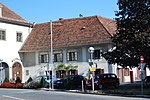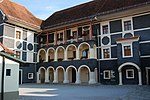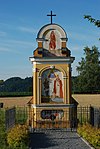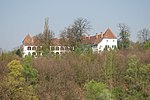List of listed objects in Fürstenfeld
The list of listed objects in Fürstenfeld contains the 35 listed , immovable objects of the community of Fürstenfeld in the Styrian district of Hartberg-Fürstenfeld .
Monuments
| photo | monument | Location | description | Metadata |
|---|---|---|---|---|

|
Catholic parish church hl. Donatus, rectory and messner house ObjectID : 56491 |
Altenmarkt bei Fürstenfeld 1 KG location : Altenmarkt bei Fürstenfeld |
ObjectID : 56491 Status : Notification Status of the BDA list: 2020-02-29 Name: Catholic parish church hl. Donatus, vicarage and Messnerhaus GstNr .: 2 Altenmarkt parish church near Fürstenfeld |
|

|
Marian column ObjectID: 19993 |
Kirchplatz location KG: Altenmarkt near Fürstenfeld |
The figure of Mary in the style of the 2nd half of the 17th century stands on a renewed column and base. |
ObjectID: 19993 Status: § 2a Status of the BDA list: 2020-02-29 Name: Mariensäule GstNr .: 23 Mariensäule Altenmarkt near Fürstenfeld |

|
Windisch Chapel ObjectID: 19994 |
KG location : Altenmarkt near Fürstenfeld |
The figure of the scourge Christ from Wies comes from the 18th century. |
ObjectID: 19994 Status: § 2a Status of the BDA list: 2020-02-29 Name: Windisch-Kapelle GstNr .: 13 |

|
Jobst Chapel ObjectID : 19995 |
KG location : Altenmarkt near Fürstenfeld |
ObjectID : 19995 Status: § 2a Status of the BDA list: 2020-02-29 Name: Jobst-Kapelle GstNr .: 569 |
|

|
Barrows and settlement Schröttenwald / Steinfeld ObjectID : 130288 |
Schröttenwald location KG: Altenmarkt near Fürstenfeld |
ObjektID : 130288 Status : Notification Status of the BDA list: 2020-02-29 Name: Tumulus and settlement Schröttenwald / Steinfeld GstNr .: 199; 200; 202; 204 |
|

|
Town hall Grazer Tor ObjectID: 19643 |
Augustinerplatz 1 KG location : Fürstenfeld |
The Grazer Tor is a two-storey gate building, part of the old city fortifications, built in 1565 instead of a simple city gate. Changed by several renovations, also as a result of war damage in 1945. The building now serves as the town hall. |
ObjectID: 19643 Status: § 2a Status of the BDA list: 2020-02-29 Name: Rathaus Grazer Tor GstNr .: .231 / 1; .231 / 2; 1760/1 Grazer Tor, Fürstenfeld |

|
Bürgerhaus ObjektID : 19638 |
Augustinerplatz 2 KG location : Fürstenfeld |
ObjectID : 19638 Status: § 2a Status of the BDA list: 2020-02-29 Name: Bürgerhaus GstNr .: .141 |
|

|
Old Town Hall, Music School ObjectID : 19644 |
Bismarckstrasse 8 KG location : Fürstenfeld |
The free house of Wilfersdorfer was to replace the worn-city tower in 1570 by Jonas of Wilfersdorf built. The building was acquired by the city in 1651 and served as the town hall until 1848, after which it was a district court and has been a music school since 1973.
The building is two-storeyed, has sloped tower substructures protruding laterally, vaulted rooms on the ground floor, a small balcony in the middle and a pillar arcade courtyard inside. The building was badly damaged in the explosion of the powder tower in 1683, which led to the rear parts being demolished in 1699. The two octagonal facade towers visible on a view of Vischer from 1680 were shortened to their present height in 1756 and 1774 due to the risk of collapse and re-covered. |
ObjectID : 19644 Status: § 2a Status of the BDA list: 2020-02-29 Name: Altes Rathaus, Musikschule GstNr .: .203 Altes Rathaus Fürstenfeld |

|
Figure St. Johannes Nepomuk ObjectID: 19632 |
Grazer Platz KG location : Fürstenfeld |
The statue dates from around 1730. |
ObjectID: 19632 Status: § 2a Status of the BDA list: 2020-02-29 Name: Figur hl. Johannes Nepomuk GstNr .: 81/1 |

|
Figure John the Baptist ObjectID : 19633 |
Grazer Platz KG location : Fürstenfeld |
The statue of John the Baptist dates from around 1730. |
ObjectID : 19633 Status: § 2a Status of the BDA list: 2020-02-29 Name: Figure Johannes the Baptist GstNr .: 81/1 |

|
Marian column ObjectID : 22374 |
Grazer Platz KG location : Fürstenfeld |
The statue of the Virgin Mary on Grazer Platz stands on a classicist base and dates from 1720. It was renovated in 1915. |
ObjectID : 22374 Status: § 2a Status of the BDA list: 2020-02-29 Name: Mariensäule GstNr .: 1723/1 |

|
Marian column ObjectID : 22373 |
Hauptplatz location KG: Fürstenfeld |
The Marian column by J. Fellner was erected on the main square in 1664. Renovated in 1954. |
ObjectID : 22373 Status: § 2a Status of the BDA list: 2020-02-29 Name: Mariensäule GstNr .: 1724/9 |

|
Cemetery Chapel, Josefi Chapel ObjectID : 19635 |
Josefigasse 5 KG location : Fürstenfeld |
The Josephi Chapel was built as a cemetery church in 1694 and was a branch of the parish church until 1832 . Since then, the church has served as a tobacco store. The chapel was enlarged in the second half of the 18th century. |
ObjectID : 19635 Status: § 2a Status of the BDA list: 2020-02-29 Name: Friedhofskapelle, Josefikapelle GstNr .: .72 Friedhofskapelle, Josefikapelle |

|
Johanniter Order Coming ObjectID: 432 |
Kirchenplatz 1a KG location : Fürstenfeld |
The Kommende , the Fürsterfeld branch of the Order of St. John , was founded after 1200, making it the oldest in the entire Habsburg Empire . Formerly connected to the rectory and church, after the war damage in 1945 only the north wing and a short west wing, both two-story, have been preserved, the former three-story box building and the south wing were destroyed. The core of the building dates from the Middle Ages, in the 17th century a chimney was added (marked 1667) and in the 18th century pillar arcades on the courtyard side (marked 1721 above the staircase). Next to the church on an archway there is a coat of arms stone with a Maltese cross , marked 1529. |
ObjectID: 432 Status: Notification Status of the BDA list: 2020-02-29 Name: Johanniter-Ordenskommende GstNr .: .123 / 1; .123 / 2; 1765 Sovereign Military Order of Malta buildings in Fürstenfeld |

|
Catholic parish church hl. John the Baptist ObjectID: 433 |
Kirchenplatz 2 KG location : Fürstenfeld |
A church was built at the same location as early as 1170.
The church was given its present-day appearance through a rococo-style renovation in 1773–1779 after it was heavily devastated during the Hajduken invasion of 1605. The second tower that existed at the time was demolished, the church widened and four oratorios installed. The church choir and the sacristy were given their present form. At that time the church already had an onion dome, which was renewed in 1853. |
ObjectID: 433 Status: § 2a Status of the BDA list: 2020-02-29 Name: Catholic parish church hl. John the Baptist GstNr .: .122 Parish Church Fürstenfeld |

|
Rectory ObjectID: 431 |
Kirchenplatz 3 KG location : Fürstenfeld |
The city parsonage from 1723 forms a closed two-storey building group with the upcoming one. Inside a Pietà from 1420, a portrait of St. Augustine from the 18th century from the former Augustinian church and a Pietà from the end of the 18th century from the former Wieskapelle . |
ObjectID: 431 Status: Notification Status of the BDA list: 2020-02-29 Name: Pfarrhof GstNr .: .121 |

|
Complete system of the former tobacco factory / area of the former princely castle ObjektID : 129327 since 2013 |
Kirchenplatz 5 including location KG: Fürstenfeld |
ObjektID : 129327 Status : Notification Status of the BDA list: 2020-02-29 Name : Entire facility of the former tobacco factory / area of the former princely castle GstNr .: .117 / 1; .118 / 1; .118 / 2; 263/2; 263/1; 265/1; 1725/4; 244/3; .118 / 3; .118 / 4 |
|

|
Former Augustinian Hermits Church ObjectID : 19637 |
Klostergasse 2 KG location : Fürstenfeld |
Built from 1365 to 1368 as a splendid mendicant order church with adjoining monastery and expanded and redesigned in the following different stylistic epochs. From 1964 the building, which was in danger of collapsing, was extensively renovated and the monastery was demolished. |
ObjektID : 19637 Status: § 2a Status of the BDA list: 2020-02-29 Name: Former Augustinian Hermit Church GstNr .: .228 / 2 Former Augustinian Hermit Church Fürstenfeld |

|
Residence, so-called Pfeilburg ObjectID : 19645 |
Klostergasse 18 KG location : Fürstenfeld |
The core of the Pfeilburg, the black tower (also known as the Swartzturm ), dates from the 13th century and is therefore one of the few surviving medieval residential towers in Styria. The building was acquired in 1490 by Hans Pfeilberg , who began the reconstruction after the Hungarian invasion of 1480, in 1550 it came to Max Ruepp , who expanded the tower and housing and was allowed to use the name Pfeilberg from 1568 . The building became a Freihaus in the 16th century . In 1691, Christoph Liscutin bought the Pfeilburg and built Austria's first tobacco factory here, a decision that shaped the city well into the 20th century. The city acquired the building in 1725, it housed a school until 1782, a barracks, a military hospital and finally a poor house and prisoner of war camp. After that, the building remained unused and fell into disrepair. The museum association saved the facility from demolition in 1975 and extensive renovation work took place from 1995 to 1999. Today the Kruzitürken- and the tobacco museum is housed in the Pfeilburg.
The core of the three-storey building dates from the second half of the 16th century, including the Renaissance bay window to the courtyard and the rusticated portal . At the southeast corner against the cavalier behind it, the remains of the wall of the old fortified tower can still be seen. In the 4th quarter of the 17th century a tower-like extension was added at a right angle, the main building was provided with two-storey pillar arcades. Inside there are still some stucco ceilings from the construction period. |
ObjectID : 19645 Status : Notification Status of the BDA list: 2020-02-29 Name: Ansitz, so-called. Pfeilburg GstNr .: .224 / 2 Pfeilburg, Fürstenfeld |

|
Former boys' elementary school, now new middle school ObjectID: 416 |
Schillerplatz 2 KG location : Fürstenfeld |
ObjectID: 416 Status: § 2a Status of the BDA list: 2020-02-29 Name: Knabenvolksschule GstNr .: 1831 |
|

|
Wieskapelle ObjectID : 19654 |
Wieskapellenweg 52 Location KG: Fürstenfeld |
The Wieskapelle, located south of the city, was donated in 1770. It consists of a transverse, oval main room with a small choir , the altar shows the hostage Christ from Wies. In 1967 the chapel was converted into a memorial for F. Priersch and furnished with paintings by Franz Weiss . |
ObjectID : 19654 Status: § 2a Status of the BDA list: 2020-02-29 Name: Wieskapelle GstNr .: .260 Wieskapelle (Fürstenfeld) |

|
Brick wall of the mill bastion ObjectID : 22376 |
Location KG: Fürstenfeld |
After several Turkish raids on the city, the fortifications began to be strengthened in 1577. In place of the medieval city towers at the corners of the city wall, protruding bastions were built. Due to financial and structural problems, the much more extensive planned fortress extension was completed in 1581 according to simpler plans. The fortification was abandoned in 1775 and renovated in 1990. |
ObjectID : 22376 Status: § 2a Status of the BDA list: 2020-02-29 Name: Brick wall of the Mühlbastei GstNr .: 195/5 |

|
Hungarian Bastion ObjectID : 22377 |
Location KG: Fürstenfeld |
After several Turkish raids on the city, the fortifications began to be strengthened in 1577. In place of the medieval city towers at the corners of the city wall, protruding bastions were built. Due to financial and structural problems, the much more extensive planned fortress extension was completed in 1581 according to simpler plans. The fortification was abandoned in 1775 and renovated in 1990. |
ObjectID : 22377 Status: § 2a Status of the BDA list: 2020-02-29 Name: Ungarbastei GstNr .: 272/4; 118/8 |

|
Bastion with cavalier behind the Pfeilburg ObjectID: 22379 |
Location KG: Fürstenfeld |
After several Turkish raids on the city, the fortifications began to be strengthened in 1577. In place of the medieval city towers at the corners of the city wall, protruding bastions were built. Due to financial and structural problems, the much more extensive planned fortress extension was completed in 1581 according to simpler plans. The fortification was abandoned in 1775 and renovated in 1990. |
ObjectID: 22379 Status: § 2a Status of the BDA list: 2020-02-29 Name: Bastei with cavalier behind the Pfeilburg GstNr .: 134/1; 110/3 |

|
Augustinerbastei, Klosterbastei ObjectID : 20404 |
Location KG: Fürstenfeld |
After several Turkish raids on the city, the fortifications began to be strengthened in 1577. In place of the medieval city towers at the corners of the city wall, protruding bastions were built. Due to financial and structural problems, the much more extensive planned fortress extension was completed in 1581 according to simpler plans. The fortification was abandoned in 1775 and renovated in 1990. |
ObjectID : 20404 Status: § 2a Status of the BDA list: 2020-02-29 Name: Augustinerbastei, Klosterbastei GstNr .: 82/1 |

|
Fortifications Vorwerk ObjektID : 21603 |
Location KG: Fürstenfeld |
ObjectID : 21603 Status: § 2a Status of the BDA list: 2020-02-29 Name: Vorwerk fortifications GstNr .: 57/2 |
|

|
Wayside shrine plague cross ObjectID : 19655 |
Location KG: Fürstenfeld |
ObjectID : 19655 Status: § 2a Status of the BDA list: 2020-02-29 Name: wayside shrine Pestkreuz GstNr .: 1735/1 |
|

|
Evang. Parish Church AB Heilandskirche ObjectID: 427 |
Location KG: Fürstenfeld |
The Protestant Heilandskirche was built in the secession style by Otto Kuhlmann in 1908–1910 . The furnishings come from the construction period, the pulpit altar with a mural by Birkle and Thomer . In the main room simple wooden galleries and a music gallery for the organ. Outside on the east gable above the entrance area a figure of the Savior. |
ObjectID: 427 Status: § 2a Status of the BDA list: 2020-02-29 Name: Evang. Parish church AB Heilandskirche GstNr .: .614 Evangelical Heilandskirche Fürstenfeld |

|
Papal Chapel ObjectID: 20004 |
at Speltenbach 34 KG location : Speltenbach |
ObjectID: 20004 Status: § 2a Status of the BDA list: 2020-02-29 Name: Papstkapelle GstNr .: 731 |
|

|
Local chapel St. Susanna ObjectID: 20003 |
KG location : Speltenbach |
ObjectID: 20003 Status: § 2a Status of the BDA list: 2020-02-29 Name: Ortskapelle hl. Susanna GstNr .: 876 |
|

|
Prehistoric settlement Buchwald ObjektID : 69448 |
Buchwald Stadtbergen Location KG: Stadtbergen |
ObjektID : 69448 Status : Notification Status of the BDA list: 2020-02-29 Name: Prehistoric settlement Buchwald GstNr .: 26; 27/1; 25th |
|

|
Figure St. Johannes Nepomuk ObjectID: 570 |
Übersbach 104 KG location : Übersbach |
Johannes Nepomuk, at the bridge on the Hartl Bach |
ObjectID: 570 Status: § 2a Status of the BDA list: 2020-02-29 Name: Figur hl. Johannes Nepomuk GstNr .: .136 |

|
Catholic branch church, St. John the Baptist ObjectID: 567 |
Übersbach 2a KG location : Übersbach |
Herrand von Wildon hands over his own Übersbacher church, which was consecrated in 1197 by the Archbishop of Salzburg, to the Order of St. John, including the right to tithes. Around 1250–1790 this church was a branch church of the Altenmarkt parish. In 1605 it was destroyed by Hajduken and enlarged again in the 17th century. It has been a branch of the Söchau parish since 1790. |
ObjectID: 567 Status: § 2a Status of the BDA list: 2020-02-29 Name: Kath. Filialkirche, hl. John the Baptist GstNr .: 1713 Filialkirche hl. John the Baptist, Übersbach |

|
Welsdorf Castle ObjectID : 36672 |
Übersbach 66 KG location : Übersbach |
Welsdorf Castle is located southwest of Fürstenfeld.
Welsdorf was originally part of the Fürstenfeld am Stein rule. At the beginning of the 16th century, Christof Perner sold the small estate and a modest Meierhof was built. Around 1550 this was acquired by Wolf von Wilfersdorf. His son built a noble seat next to the Meierhof, for which he received permission in 1603 to name it "Wolfsdorf". When the Haiduken invasion of 1605, the manor and the Meierhof were burned down together with the village of Übersbach. The reconstruction was slow. In 1701 the Augustinian canon monastery at Pöllau bought Welsdorf. The castle was expanded into a four-wing complex and used as the summer residence of the provosts. Three of the four massive square corner towers are still preserved. The loopholes in the attic of the northwest tower are among the castle's oldest structural details. This was once surrounded by a wall and bastions. Nothing has been preserved from the former fortifications. |
ObjectID : 36672 Status : Notification Status of the BDA list: 2020-02-29 Name: Schloss Welsdorf GstNr .: 809/3 Schloss Welsdorf |

|
Marian Column ObjectID: 568 |
Location KG: Übersbach |
The Marian column was built after the Turkish battle near Mogersdorf in 1664 and is believed to have been made by the Hartberg sculptor Johannes Fellner. Framed by the war memorial for the fallen and missing of the two world wars. |
ObjectID: 568 Status: § 2a Status of the BDA list: 2020-02-29 Name: Mariensäule GstNr .: 1611 Mariensäule Übersbach |
literature
- Kurt Woisetschläger , Peter Krenn : The art monuments of Austria. Dehio-Handbuch Steiermark: (excluding Graz) . Anton Schroll & Co, Vienna, 1982, published by the Federal Monuments Office , ISBN 3-7031-0532-1
Web links
Individual evidence
- ↑ a b Styria - immovable and archaeological monuments under monument protection. (PDF), ( CSV ). Federal Monuments Office , as of February 18, 2020.
- ^ A b Kurt Woisetschläger, Peter Krenn: Die Kunstdenkmäler Österreichs. Dehio-Handbuch Steiermark: (excluding Graz) . Ed .: Federal Monuments Office. Anton Schroll & Co, Vienna 1982, ISBN 3-7031-0532-1 , p. 16 .
- ^ Franz Timischl: Museum Pfeilburg Fürstenfeld. Retrieved January 7, 2012 .
- ↑ § 2a Monument Protection Act in the legal information system of the Republic of Austria .
